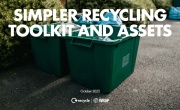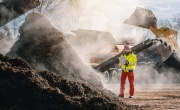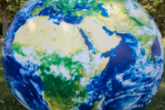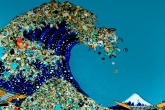Microplastics found in stomachs of organisms living in the deepest part of the Pacific Ocean
The beauty of Blue Planet II, the latest offering from David Attenborough, is that it transported us to a vast world of untouched marine ecosystems, seemingly beyond human reach. But don’t be fooled by the mise en scène. Researchers have discovered our plastic waste is now littering the deepest ocean floor on the planet and is being ingested by the microorganisms which live there.
The research, led by Dr Alan Jamieson from the University of Newcastle, tested samples of deep-sea crustaceans by dropping landers into the ultra-deep trenches that span the entire Pacific Ocean to depths ranging from seven to 10 kilometres, including the Mariana Trench at 10,890 metres deep.
Not only were plastic particles discovered in the deepest part of the earth’s oceans, but they appear to be ubiquitous. The team examined 90 individual animals and found ingestion of plastics ranged from 50 per cent in the New Hebrides trench (over 7,000 metres deep) to 100 per cent at the bottom of the Mariana, the deepest known part of the world’s oceans.
“The results were both immediate and startling,” said Dr Jamieson. “This type of work requires a great deal of contamination control but there were instances where the fibres could actually be seen in the stomach contents as they were being removed."
The fragments identified included semi-synthetic microfibres used in products like textiles, such as nylon, polyethylene, polyamide, or unidentified polyvinyls closely resembling polyvinyl alcohol or polyvinylchloride - the most widely used hard plastic polymers, PVA and PVC.
“We felt we had to do this study given the unique access we have to some of the most remote places on earth, and we are using these samples to make a poignant statement about mankind’s legacy,” he added.
“These observations are the deepest possible record of microplastic occurrence and ingestion, indicating it is highly likely there are no marine ecosystems left that are not impacted by anthropogenic debris.”
Dr Jamieson was part of the team to first discover deep-sea creatures living at the bottom of the Pacific Ocean’s deepest ridges. But the opportunity to further understand these ecosystems may now be hindered, according to the senior lecturer. “This study has shown that manmade microfibres are culminating and accumulating in an ecosystem inhabited by species we poorly understand, cannot observe experimentally and have failed to obtain baseline data for prior to contamination.”
The foundation successfully raised $21.7 million (£16.8 million) after a fundraising campaign and is due to begin testing its plastic capture system of floating barriers this year. It hopes to begin the cleanup next year and aims to completely clear the Pacific Garbage Patch by 2023.
However, as the latest research supports, the degradation and fragmentation of plastics on the surface inevitably mean it ends up drifting onto the seafloor where it is effectively impossible to clear up and can enter the food chain via deep-sea organisms which mistakenly catch the small particles for food.
“Deep-sea organisms are dependent on food raining down from the surface,” explains Dr Jamieson, “which in turn brings any adverse components, such as plastic and pollutants with it.The deep sea is not only the ultimate sink for any material that descends from the surface, but it is also inhabited by organisms well adapted to a low food environment and these will often eat just about anything.”
Furthermore, research in May 2016 by Eunomia estimated that barely one per cent of marine plastics can be found on or near the surface of the world’s oceans. It found that, on average, there is less than 1kg found in each square kilometre (km2) of ocean, except for areas like the Great Pacific Garbage Patch where the concentration goes up to 18kg/km2. It concluded that 94 per cent of plastic that enters the ocean actually ends up on the seafloor, and estimated there is on average 70 kg of plastic for each square kilometre of seabed.
Presenting the conclusions from the Eunomia research, Chris Sherrington responded to reactive strategies to plastic pollution, saying: “Prevention is usually better than cure, and there’s a lot more we could do to stop plastic pollution from entering the marine environment in the first place. Preventing waste and preventing litter go hand in hand.”








